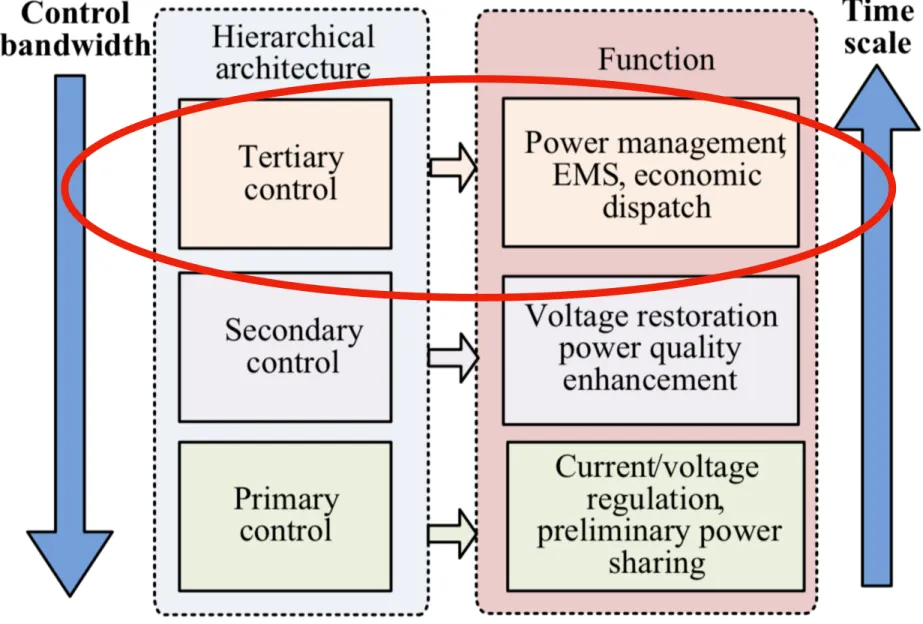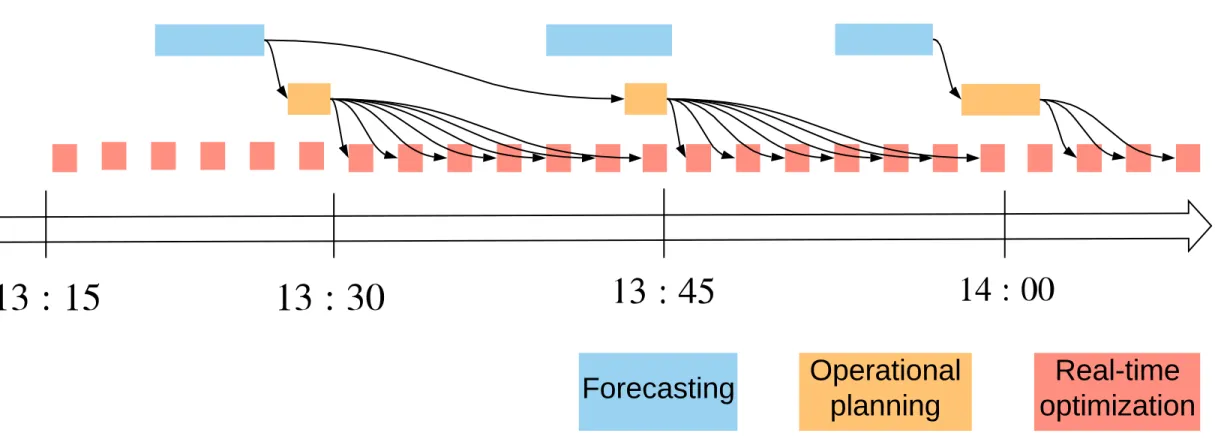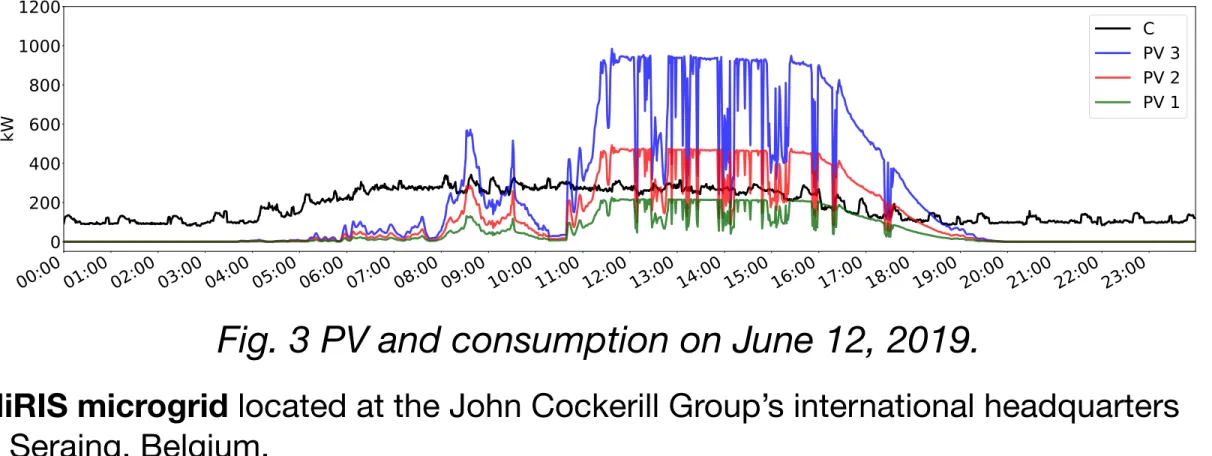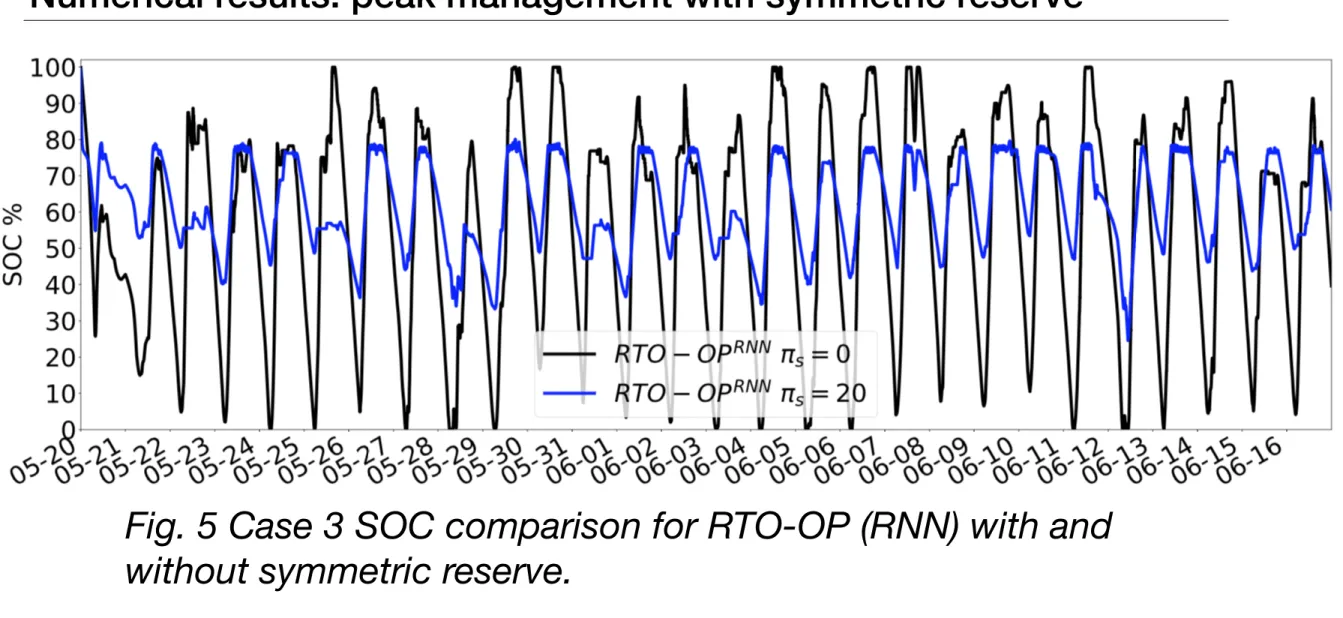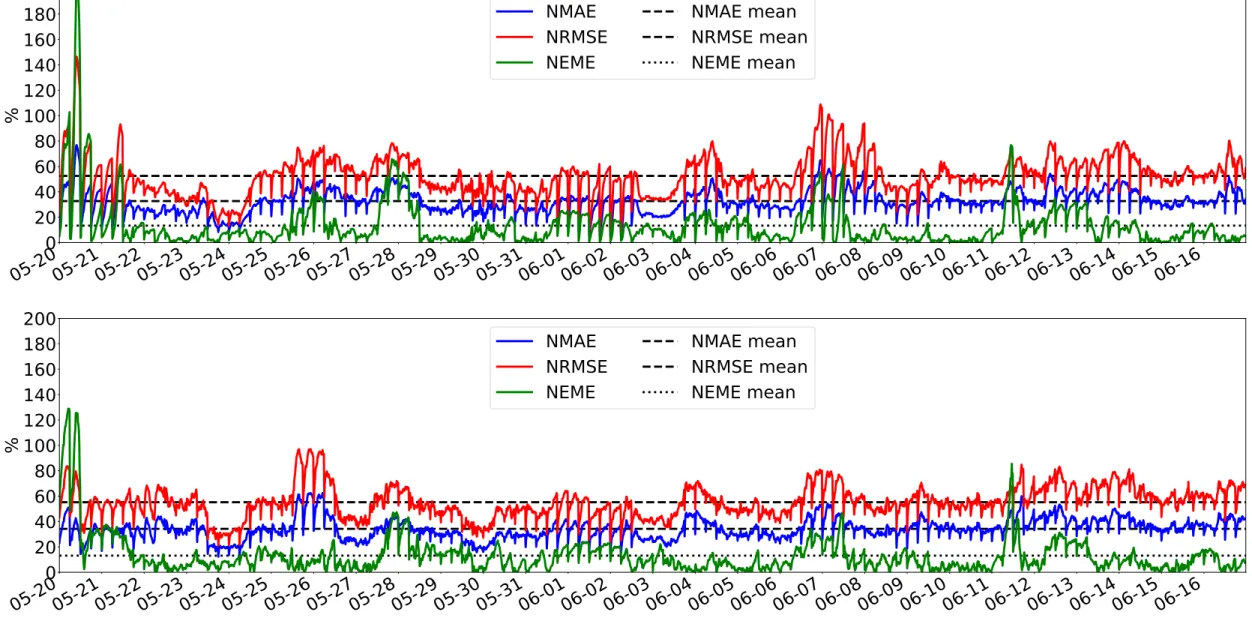Coordination of operational planning and
real-time optimization in microgrids
Jonathan Dumas, Selmane Dakir, Clément Liu, Bertrand Cornélusse
Department of electrical engineering and computer science ULiège, Liège, Belgium
Fig. 1 Hierarchical control architecture.
Microgrid hierarchical control
Literature: two-layer approach Schedule layer:
-
economical operation scheme;-
24 hours ahead, 15 min resolution.Dispatch layer:
-
Computes set points based on the schedule and the microgrid status;-
15 min ahead, resolution of a few seconds.How interact the schedule and dispatch layers ?
Two-layer approach intensively studied:
[2] Jiang, Quanyuan, Meidong Xue, and Guangchao Geng. "Energy management of microgrid in grid-connected and stand-alone modes." IEEE transactions on power systems 28.3 (2013): 3380-3389.
[3] Wu, Xiong, Xiuli Wang, and Chong Qu. "A hierarchical framework for generation scheduling of microgrids." IEEE Transactions on Power Delivery 29.6 (2014): 2448-2457.
[4] Sachs, Julia, and Oliver Sawodny. "A two-stage model predictive control strategy for economic diesel-PV-battery island microgrid operation in rural areas." IEEE Transactions on Sustainable Energy 7.3 (2016): 903-913.
[5] Cominesi, Stefano Raimondi, et al. "A two-layer stochastic model predictive control scheme for microgrids." IEEE Transactions on Control Systems Technology 26.1 (2017): 1-13.
[6] Ju, Chengquan, et al. "A two-layer energy management system for microgrids with hybrid energy storage considering degradation costs."
PSCC 2020
Summary
1. Problem formulation
2. Proposed method
3. Case study description
4. Numerical results
5. Conclusions & perspectives
PSCC 2020
Abstract problem formulation
This problem is very difficult to solve since the evolution of the system is uncertain,
actions have long-term consequences, and are both discrete and continuous.
a⋆ 𝒯l(t) = arg min ∑ t′∈𝒯l(t) c(at′, st′, ̂ωt′) s.t. ∀t′ ∈ 𝒯l(t), st′+Δt′ = f(at′, st′, ̂ωt′, Δt′), st′ ∈ S′t at = (am t , atd) st = (stm, std)
Actions set: market related (m) and set points to the devices (d).
Microgrid state: related to the market (m) and devices (d).
c f
Cost function.
Transition function of the system.
̂ωt Uncertainty.
(1)
Summary
1. Problem formulation
2. Proposed method
3. Case study description
4. Numerical results
5. Conclusions & perspectives
PSCC 2020
Forecasting Operational planning Real-time optimization Planner
PSCC 2020
c(at, st, wt) = cm(am t , st, wt) + cd(atd, st, ωt) Controller vt(s)Proposed method: two-layers with a value function
Fig. 2 Hierarchical control procedure illustration.
Two-layers approach with a value function to propagate information from
PSCC 2020
Proposed method: two-layers with a value function
am,⋆ 𝒯ma(t) = arg min ∑ t′∈𝒯m a(t) cm(am t′ , st′, ̂ωt′) s.t. ∀t′ ∈ 𝒯ma(t), st′+Δτ = f m(at′m, st′, ̂ωt′, Δτ) st′ ∈ St′ (2) Operational planner: Real-time controller: ad,⋆ t = arg min cd(atd, st, ̂ωt) + vτ(t)(sτ(t)) s.t. sτ(t) = fd(atd, st, ̂ωt, τ(t) − t) sτ(t) ∈ Sτ(t) (3) vt(sτ(t)) Value function at the end of the first market
PSCC 2020
Proposed method: objective function of the operational planner
COP t′ = ( ∑ d∈𝒟she Δτπshe d,t′Cd,t′shead,t′she + ∑ d∈𝒟ste Δτπste d,t′Cd,t′stead,t′ste + ∑ d∈𝒟nst Δτπnst d,t′Cd,t′nstad,t′nst + ∑ d∈𝒟sto
Δτγdsto(Pdηdchaad,t′cha + Pd
ηdis
d a
dis d,t′)
− πe
t′et′gri + πt′iit′gri) selling/purchasing energy to/from the grid
shed demand steered generation non steered generation
storage fee
DOP
t′ = πpδpt′ − πOPs rt′sym peak cost and symmetric reserve
JOP
𝒯ma(t) = ∑
t′∈𝒯m
a(t) (C
OP
t′ + Dt′OP) (4) Immediate and delayed costs.
PSCC 2020
Proposed method: objective function of the real-time controller
JRTO
t = CtRTO + DtRTO + vτ(t)(sτ(t)) (5) Immediate, delayed costs, and value function.
Real-time controller:
Value function = cost-to-go at the end of the ongoing market period as a
function of the state of charge.
Evaluated by solving (4) for several states of charge = parametrization by
changing the RHS -> provide cuts.
Cut 1 to 3: sτ(t) = s1 [μ1] → vτ(t)(s) ≥ vτ(t)(s1) + μ1Ts sτ(t) = s2 [μ2] → vτ(t)(s) ≥ vτ(t)(s2) + μT 2 s sτ(t) = s3 [μ3] → vτ(t)(s) ≥ vτ(t)(s3) + μT 3 s
Summary
1. Problem formulation
2. Proposed method
3. Case study description
4. Numerical results
5. Conclusions & perspectives
PSCC 2020
MiRIS case study
Fig. 3 PV and consumption on June 12, 2019.
27 days of data (measurements and point forecasts) available on the Kaggle platform:
https://www.kaggle.com/jonathandumas/liege-microgrid-open-data
MiRIS microgrid located at the John Cockerill Group’s international headquarters
in Seraing, Belgium.
https://johncockerill.com/fr/energy-2/stockage-denergie/
PSCC 2020
MiRIS case study: managing the peak penalty
Table I: Case study parameters.
C = load S = Battery
Peak penalty if import > 150 kW paid at 40 euros / kW Day/night import prices: 200/120 euros MWh.
Single export price 35 euros /MWh.
Summary
1. Problem formulation
2. Proposed method
3. Case study description
4. Numerical results
5. Conclusions & perspectives
PSCC 2020
Numerical results: RTO-OP vs RBC
Planner (OP):
-
24 hours ahead;-
15 min resolution;-
run on a quarterly basis.Controller (RTO):
-
15 min ahead;-
run on a one minute basis.PSCC 2020
RTO-OP is compared to a Rule Based Controller (RBC).
Numerical results: RTO-OP vs RBC
PSCC 2020
PV and consumption weather based point forecasts for OP use
Recurrent Neural Network (RNN) and Gradient Boosting Regression (GBR) techniques.
The weather forecasts provided by the Laboratory of Climatology of the
Numerical results: peak management
PSCC 2020
Table II: Results without symmetric reserve.
energy cost (k euros) peak cost (k euros) total cost (k euros) peak power (kW)
RTO-OP is still a long way to manage the
peak as RTO-OP* due to the forecasting errors.
RTO-OP optimizes PV-storage usage, and
thus requires less installed PV capacity for
a given demand level than RBC.
cE cp
ct = cE + cp Δp
PSCC 2020
RTO-OP tends to maintain a storage level that allows to better cope with forecast error.
Numerical results: peak management with symmetric reserve
Fig. 5 Case 3 SOC comparison for RTO-OP (RNN) with and without symmetric reserve.
PSCC 2020
Table III: Results with symmetric reserve for RTO-OP (RNN)
There is an economic trade-off to reach to manage the peak and the
reserve simultaneously depending on the valorization or not on the market of the symmetric reserve.
The peak power has decreased. Numerical results: peak management with symmetric reserve
Summary
1. Problem formulation
2. Proposed method
3. Case study description
4. Numerical results
5. Conclusions & perspectives
PSCC 2020
Conclusions & extensions
The value function computed by the operational planner based on PV
and consumption forecasts allows to cope with the forecasting
uncertainties.
The approach is tested in the MiRIS microgrid case study with PV and
consumption data monitored on site.
The results demonstrate the efficiency of this method to manage the
peak in comparison with a Rule Based Controller.
Extension to a stochastic/robust formulation to deal with
probabilistic forecasts.
Extension to a community by considering several entities inside the microgrid.
Annex: Point forecasting methodology Inputs:
-
PV production / Load historical data-
Weather forecast from the laboratory of climatology of Liège.Outputs:
- PV production / load 24 ahead hours with 15 min resolution
The point forecasts are computed on a quarterly basis using a Long Short
Term Memory (LSTM) with the keras python library [8] and a Gradient Boosting Regression (GBR) with the scikit-learn python library [9].
The forecasting process is implemented using a rolling forecast
methodology. The Learning Set (LS) is refreshed every six hours and
limited to the week preceding the forecasts.
[8] F. Chollet et al., “Keras,” https://keras.io, 2015.
Annex: Point forecasting results
